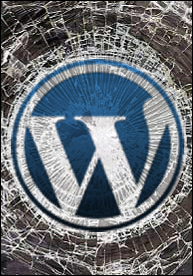 WordPress, like any software, has the ability to break and that then can cause a blog owner quite a bit of anxiety. This can be caused by plugins not working properly, file corruption, database problems, or many other things. Even though your data is usually just fine, having a blog down is not what a blog owner wants.
WordPress, like any software, has the ability to break and that then can cause a blog owner quite a bit of anxiety. This can be caused by plugins not working properly, file corruption, database problems, or many other things. Even though your data is usually just fine, having a blog down is not what a blog owner wants.
Here are 5 things you can do to try to fix a broken WordPress Install.
Before trying to fix any issues, make sure to back up your blog! The fixes below should not cause any harm, but it’s always better to have a backup you don’t need than not to have a backup when you need it.
Items to back up:
- Your /wp-content/ folder
- Your blog’s database.
- Use the wp-backup plugin to make backups easy.
1. Disable Plugins
Plugins add a lot of additional features and functionality to a blog but can cause also cause unexpected issues such as admin pages that show nothing but a white screen, slow loading pages, or PHP error messages on public facing pages.
To disable plugins you can go to the plugins screen on the admin side, select all, and then disable them. Once disabled, go back through and ensure the issue is gone. Then, enable the plugins one at a time until you find the one causing the issue.
If for some reason you can’t get to the plugins page, you can FTP into your blog and rename the plugins folder. The next time that you try to load the plugins page in WordPress, it’ll not be able to locate the plugins folder and de-activate all plugins. Renaming the folder back will bring all the plugins back but keep them deactivated. Then, enable the plugins one at a time until you find the one causing the issue.
Once the plugin with the issue is located, you can choose to remove it or check the plugins homepage for updates.
2. Check Your Config File
If your blog is not loading at all, and you see an error message that says ‘cannot connect to database,’ connect to the site via FTP and check the wp-config.php file to ensure the username, password and database names are correct. If it is, and you’re still having issues, contact your hosting provider to see if there are any database related changes or issues that you should know about.
3. Re-Install WordPress
Most of the WordPress files can be re-installed without causing any issues with the blog. The only directory NOT to touch is /wp-content/.
You can re-install WordPress’ files by logging into WordPress and going to Tools -> Upgrade and selecting the re-install option. WordPress will use the built-in updater to re-install all core files but not touch any theme or plugin files.
If you can’t use the built-in WordPress tool to re-install WordPress, you can upload the files via FTP. Just be sure not to overwrite the /wp-content/ folder as this contains your theme, upload, and plugins folder. The best solution is to first delete the old files before uploading the new ones.
4. Repair Database Tables
If your problem doesn’t appear to be with a plugin or the core WordPress files, you can always try to repair the database tables via phpMyAdmin.
Log into the blog’s database via phpMyAdmin, check all the database tables, and select Repair. You can also choose to optimize them as well.
To get access to your blogs phpMyAdmin, contact the hosting provider.
5. Something Else Is Wrong?
If the blogs issue still exists then it’s time to head over to the WordPress support forums and ask for help or do a search on the error message, or problem, and see if someone else is having the issue. Chances are you aren’t the only one and the solution is just waiting for you to find it.
In my experiences with WordPress, there have been very few big issues. At times a plugin has gone rogue, or comments have disappeared, but a few maintenance items and things have gone back to normal with no loss of posts or comments.
WordPress is a smart blogging platform and most issues can be fixed quickly without any harm to the blog content.



